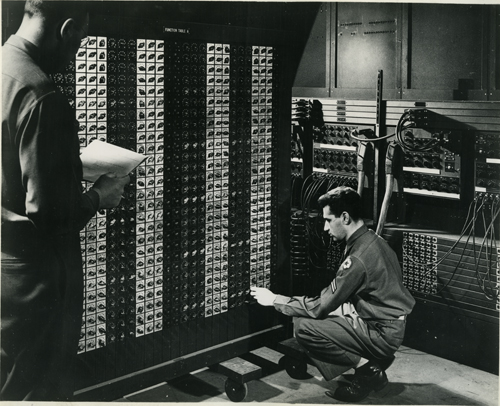
so this gif has been making the rounds, with the unhelpful title of "data cable on a computer from 1945". but what computer? what sort of data? let's find out.🧵
https://twitter.com/i/status/1464176912503390223
the gif is from this YouTube video, an introduction to the ENIAC, where they interview some folks and show off the pieces of the ENIAC on display at the University of Pennsylvania.
chip designers like to talk about "floor planning" but this is the floor plan of the first programmable electronic computer. 

at first you couldn't program the ENIAC, at least in the modern sense. basically you wired the modules together like it was some room-sized modular synthesizer. 

to use another modern analogy, the computer was more like an FPGA than a CPU. lots of modules that you could wire up however you wanted.
anyway, back to this thing. let's see if we can figure out what it does based on the panel that it is plugged into. 

so what's the portable function table? it's this wheeled monstrosity! you can see the two large cables poking out the side. these plug into two function table front panels. 

you could unplug them from a panel and hang up the connector, sort of like a gas pump, and then wheel the whole contraption over to a different front panel, depending on how you were configuring the machine. 

ok but what does the portable function table actually DO? glad you asked...
it is basically a look-up table. you get 104 entries of 20 digit numbers, each decimal digit represented by a 10-position knob! 



the function table receives decimal pulses from the computer, uses a counter circuit to select a particular row of knobs, and spits the value of that row (set by the knobs) back out to the computer.
in the late 1940s, folks figured out a way to configure the machine so that you could store instructions in the function table. to change the program, you'd just go and tweak the knobs, and you never really had to bother with rewiring the machine for a particular task.
so what would the equivalent storage space be in this "knob ROM"? there are 1,456 knobs total, each storing a single decimal digit (since the ENIAC was decimal). to go to bytes, we have 1456*log2(10)/8 = 604 bytes, or about two tweets worth of text! 

if you want to read more, you can find the ENIAC operating manual here: bitsavers.org/pdf/univOfPenn…
i was reminded that the giant plug was also used by the ENIAC's IBM-made punch card reader and the printer. turns out IBM used it for other equipment as well.
https://twitter.com/bitsavers/status/1464345531073720320
• • •
Missing some Tweet in this thread? You can try to
force a refresh
























